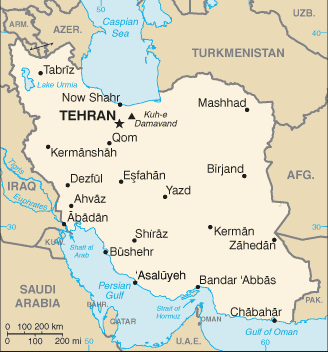Why does India need Iran?

Map sourced from the library of the University of Texas
Take a look a map of West Asia. If not for Iran, India would have to take a long detour and pass through the Arabian peninsula, comprising a clutch of Gulf Cooperation Council countries, and then transit through either Syria, Jordan or Iraq to enter Turkey and then turn eastward to Central Asia. Quite a protracted and expensive detour compared to what Iran offers with its borders with Armenia, Afghanistan, Turkmenistan, Azerbaijan and the Caspian Sea. With Pakistan still unrelenting to grant India overland access to Afghanistan and the rest of the region, Iran happens to be India’s only bet. And that is a reason important enough for maintaining good ties with Tehran.
With all due credit, this is something that has not eluded our strategists; India and Iran have launched transport infrastructure projects as Delhi seeks the shortest route to Central Asia. But progress has been meagre and undoubtedly hampered by nuclear politics.
The most ambitious of all is the Border Roads Organisation’s ongoing exercise to build a road from Delaram to Zaranj in southwest Afghanistan. That several Indians working on this stretch have either been kidnapped or killed by those inimical to a growing Indian reach only highlights its immense geopolitical importance. The idea is to link Afghanistan’s network of highways to Zaranj that is located on the border with Iran. And then link Zaranj with Iran’s network of road and rail to the Chabahar port, south of Iran near Bandar Abbas, that India is helping rebuild. When this network is finally in place, landlocked Afghanistan will have access to another port and not necessarily pass through Karachi. More importantly, this network will allow India to bypass Pakistan in its trade with Afghanistan and Central Asia.
While progress has been made in Afghanistan, things have not moved ahead in Iran. Meanwhile, China has gone ahead and constructed the port at Gwadar in Pakistan and linked it with roads from there leading to the Karokaram highway and into China. Gwadar has thus lent China a strategic hold on the sea lanes in the zone. Indian Naval Chief Admiral Sureesh Mehta feels the port would also “enable Pakistan take control over the world energy jugular (Strait of Hormuz) and interdiction of Indian tankers”. The port at Chabahar, on the hand, is yet to be developed and has been undoubtedly affected by the fallout of the Iranian nuclear crisis. The contract to do so was awarded in 2004 to the Hindujas, who are partnering with the Indian government’s RITES and IRCON. Some Iranian analysts argue Iran has deliberately been reticent on Chabahar because of India’s anti-Iranian position at IAEA.
But Mahmoud Ahmadinejad’s visit yesterday has brought in new momentum and one hopes the two countries will be able to set aside their differences and pursue this project. India, it was announced, will also be cooperating with Iranian authorities to develop a 600-km long Chabahar port and Fahraj rail line that is part of a multi-modal transport corridor to Russia via Iran.
Both countries stand to gain: India gets uninterrupted access to Central Asia and Iran earns a substantial transit fee on transactions through Chabahar.


0 Comments:
Post a Comment
Subscribe to Post Comments [Atom]
<< Home